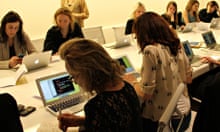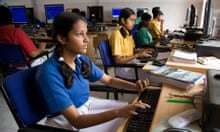For three years we have run a big coding event across the UK called Young Rewired State . We invite people aged 18 and under to get together at a variety of centres local to them, and build something using open government data. It ends with a big overnight festival of code at the National Museum of Computing, Bletchley Park, with talks and presentations of what the young people have built.
In our first year, 2009, 50 young people took part; this time we are expecting 500. At the festival the one question I am asked regularly is: "Where are the girls?"
The answer is this: a maximum of 5% at the festival each year are girls. You may not have seen them all on stage, since some are uncomfortable with public speaking – especially if there is a risk that they'll be "outed" as a geek. As the mother of two daughters – one aged 14 with no interest in programming, and one aged nine who is fascinated by it – I have been particularly interested in exploring the reasons behind the lack of girl geeks in YRS, which simply reflects the dire male-female ratio in the adult coding programming world. These are my conclusions:
Girls become self-conscious and socially conscious at around puberty and have enough to contend with as they negotiate their move to senior school, where they feel more pressure to fit in, in order to survive and build a new social group of friends.
Coding and digital prowess is still niche at a young age, self-taught by the studious. It is often considered a bit nerdy in senior school, where it is not currently taught as a part of the curriculum, although this is changing in senior schools from September 2012. Therefore, generally speaking, those who code have taught themselves. Teaching yourself something that should really be covered as a part of lessons is a bit like doing extra homework – why, ask many teens, would anyone do that? There is no way the majority of hormonally challenged, desperate-to-find-their-place-in-the-world teenage girls would risk ridicule or isolation by doing such a thing – let alone be open and proud about it. (Boys of the same age have different social challenges and do not measure their societal worth so much by peer review.)
Last but not least, there are no great British young geek superstars for them to relate to, male or female.
The fear of exposure to ridicule is important and is why I reckon YRS gets a greater female drop-out rate just before the event. They sign up because they want to; they drop out because they cannot face the potential embarrassment. If only they knew how heralded they would be by the achingly cool. But even the achingly cool kudos doesn't win against female peer group pressure.
So what's the answer? I hate to limit this to just the girl geek question, but perhaps in solving the problem of a dearth of female coders we can make a big dent in the broader issue of teaching programming as a part of the national curriculum – in spite of Michael Gove's vision of open education. Gove's solution of opening up the possibility of teaching computer science, where schools can find the talent and wherewithal to do so, still focuses on senior school education: GCSEs mainly, and so will still suffer the same difficulties attracting the girls. I am sure that some teachers will succeed, of course, but generally speaking the anthropology still works against this as a blanket solution.
In my opinion, Year 8 is too late. We need to start teaching digital literacy and coding as a part of the curriculum in Year 5, when most children's maths is strong enough. The curriculum has fostered a familiarity with computing and computers and the young minds are ready to start learning programming languages. Indeed primary school children are creative, excited and less likely to have developed associations, good or bad, with certain subjects.
If programming can be introduced as a part of the central curriculum in Year 5, I'd bet my last penny that by the time those kids are drawn up through the education system, you would find far less disparity between the sexes. Not to mention an increased number of talented young people with an ability to manipulate open data, relate to code and challenge one another to design and build digital products that you and I have not even begun to imagine.
So, make one simple change: teach programming in Year 5 and thereafter make it a relevant and necessary part of the curriculum. Then you'll see the girls.
Emma Mulqueeny is the co-founder of Rewired State
You can hack it. Here's how
Rewired State runs hack days. Every summer they organise a week of mentored programming for young people across the UK.
The 2012 event runs from 6-11 August. During that week businesses, small and large, around the country act as hosts to local young people, YRS alumni, Rewired State mentors and other volunteers. A challenge is set to build digital products: mobile and web, using at least one piece of open data.
It is free for any child to enter so long as they are aged 18 or under and have a rudimentary understanding of programming. The event is funded through crowdfunding. To make Young Rewired State's Code Fest happen, pledge a tenner at peoplefund.it
Details at youngrewiredstate.org






